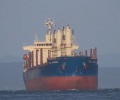

The Baltic Exchange’s main sea freight index, which tracks rates for ships ferrying dry bulk commodities, fell on Friday as lower rates for capesizes offset gains in the panamax segment.
The overall index, which factors in rates for capesize, panamax, supramax and handysize shipping vessels, crept lower by 5 points, or about 0.2%, to 3,371.
However, the main index was up 2.4% for the week, its third straight weekly gain.
The capesize index dropped 55 points, or 1.2%, to 4,359. It was up 1.2% for the week, gaining for a third straight week.
Average daily earnings for capesizes, which typically transport 150,000-tonne cargoes such as iron ore and coal, were down by $458 to $36,150.
Chinese steel and iron ore futures traded in tight ranges on Friday with all recording weekly declines on weak seasonal demand and speculation this week about a possible easing of controls on output.
China’s import demand growth is forecast to taper off in the coming quarter, “which is likely to help dry bulk shipping rates stabilise as well. Given how tight these shipping lines are, any new disruption to trade could pose upside risks to agricultural and metal prices,” credit rating agency Fitch noted in its research note on Thursday.
The panamax index rose 31 points, or around 1%, to 3,449, the highest since July 27.
The index was up 4.4% for the week, its first weekly gain in five.
Average daily earnings for panamax, which usually carry coal or grain cargoes of about 60,000 to 70,000 tonnes, increased by $283 to $31,041.
The supramax index rose 13 points to 2,996 and was up 2.2% for the week, its third straight weekly gain.
Source: Reuters (Reporting by Seher Dareen in Bengaluru; Editing by Subhranshu Sahu)